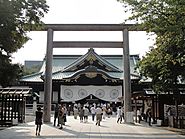-
About
- About Listly
- Community & Support
- Howto
- Chrome Extension
- Bookmarklet
- WordPress Plugin
- Listly Premium
- Privacy
- Terms
- DMCA Copyright
- © 2010-2025 Boomy Labs


 jyothi-nagaraja26
jyothi-nagaraja26
Listly by jyothi-nagaraja26
Shinto is the native religion of Japan, its main practice being the worship of clan deities and local deities inhabiting mountains, rivers, and other natural features. It has no doctrine or scriptures and the most well-known shrines belong to the imperial and old aristocratic clans. As a place of worship, people come in order to pay their respects to the kami. You can also ask for good fortune. As normally shown in anime, manga or television, you can also draw your fortune and see what luck you will have.

Kotohira-gū shrine is a Shinto shrine in the town of Kotohira in Nakatado District, Kagawa, Japan. Perched on Mount Zozu, the Kotohiragu Shrine has a rather challenging course with over 700 granite steps. Kotohira-gu Shrine houses important Japanese cultural artifacts and edifices including the Heian statue of Kannon Bosatsu and the four-ink paintings of Maruyama Okyo.

Fushimi Inari Taisha is the head shrine of Inari, located in Fushimi-ku, Kyoto, Japan. It is a very important Shinto shrine in Southern Kyoto. As its name states, the shrine is dedicated to Inari the Shinto god of rice. You will see the Romon Gate donated by Toyotomi Hideyoshi at the shrine’s entrance. This is the shrine famed for its vermilion Senbon Torii (thousands of tori gates). Many unique and diverse festivals are held throughout the year – such as the tea festival, fire festival and the rice festival. Many visitors (especially foreigners) go to Fushimi Inari for its mountain trails aside from visiting the shrine itself.

The Ise Grand Shrine located in the city of Ise, Mie Prefecture of Japan, is a Shinto shrine. It has two main shrines, the Naiku (Inner Shrine)- devoted to Amaterasu-ōmikami (Solar Goddess and ancestral deity of the Imperial family) and Geku (Outer Shrine)-devoted to Toyouke (the deity of food, housing and clothing).It is the focal point of Shintoism and is regarded as one of the most important and holiest sites in Japan. The architectural style of the Ise shrine is known as shinmei-zukuri, characterized by extreme simplicity and antiquity. Its basic principles date back to the Kofun period.

Itsukushima Shrine is a Shinto shrine on the island of Itsukushima popularly known as Miyajima, best known for its "floating" torii gate. The shrine and its torii gate are unique because they were built over water. Its as if they are floating in the sea when viewed during high tide. . The shrine is dedicated to the three daughters of Susano-o no Mikoto, Shinto god of seas and storms, and brother of the sun goddess Amaterasu . Because the island itself has been considered sacred, commoners are not allowed to set foot on it throughout much of its history to maintain its purity

Meiji Shrine located in Shibuya, Tokyo, is the Shinto shrine that is dedicated to the deified spirits of Emperor Meiji and his wife, Empress Shoken. The Shrine is surrounded by a forest and walk trails which you can take a while to relax in. The peaceful forest contrasts to the busy Tokyo city outside. The shrine is also famous for its exquisite architecture as well as its collection of exhibits that are believed to be the personal belongings of Empress Shoken and Emperor Meiju.

Nikkō Tōshō-gū is a Shinto shrine located in Nikkō, Tochigi Prefecture, Japan. It was built in 1617 is considered to be valuable for its historical architecture, Grand Oishi Torii Gate and bronze garden lanterns. The five-storey pagoda was donated by a daimyō in 1650, but it was burned down during a fire, and was rebuilt in 1818. Each storey represents an element–earth, water, fire, wind and aether (or void) in ascending order.

The Hirano Shrine is a Shinto shrine in the city of Kyoto. This shrine is known and popular for its gardens and many trees. The main shrine in the unique Hirano-style is designated an important cultural property. The shrine has been the site of a cherry blossom festival annually since 985. The long history of festivals at the Shrine began during the reign of Emperor Kazan, and it has become the oldest regularly held festival in Kyoto.

Kifune Shrine is a Shinto shrine located at Sakyō-ku in Kyoto, Japan. . Many legends surround the town making it an interesting visit for tourists.The shrine is dedicated to the god of water and rain and hosts a Kifune Shrine Water Festival annually. The deity of water is enshrined at Kifune-jinja where Shinto rituals calling for rain to start or end have been held since ancient times. It is also believed to be a deity of matchmaking.

Yasukuni Shrine is a Shinto shrine located in Chiyoda, Tokyo, Japan. It was founded by Emperor Meiji. It houses the souls of some 2.5 million people killed in Japan’s wars. Various Shinto festivals are associated with the shrine, particularly in Spring and Autumn seasons when portable Mikoshi shrines are rounded about honoring the ancestral gods of Japan.

Fuji Omuro Sengen Shrine is the oldest Mt. Fuji Shinto shrine on the shore of Lake Kawaguchi, which was patronized by the Takeda feudal family with military prestige in the Sengoku Period. Every April, the Spring festival called ‘Hana Matsuri’ (Flower Festival) is held at Fuji Omuro Sengen Shrine, which features many stalls and attractions in the shrine on that day, providing a truly festive atmosphere.